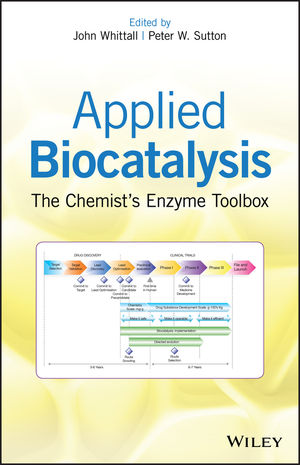
November 2020-2: HIMS-Biocat group contributes to “Applied Biocatalysis” book
Our group has contributed with three sections to the book entitled: “Applied Biocatalysis — The Chemist’s Enzyme Toolbox” edited by John Whittall and Peter W. Sutton and published by Wiley.
To quote the Editor’s words: “The book includes shorts but detailed experimental methods on timely novel biocatalytic transformations using new enzymes or new methodologies using known enzymes”.
Book section by HIMS-Biocat group
- Chapter 5, section 5.6, pages 221-231: “Asymmetric reductive amination of ketones catalyzed by amine dehydrogenases” by Vasilis Tseliou, Wesley Böhmer, Maria L. Corrado, Marcelo F. Masman, Tanja Knaus and Francesco G. Mutti.
- Chapter 11, section 11.7, pages 449-445: “Aerobic synthesis of aromatic nitriles from alcohols and ammonia using galactose oxidase” by Jan Vilím, Tanja Knaus and Francesco G. Mutti.
- Chapter 11, section 11.8, pages 455-468: “Hydrogen-borrowing conversion of alcohols into optically active primary amines by combination of alcohol dehydrogenases and amine dehydrogenases” by Maria L. Corrado, Vasilis Tseliou, Joseline A. Houwman, Wesley Böhmer, Jan Vilím, Marcelo F. Masman, Tanja Knaus and Francesco G. Mutti.
About the Book
Provides clear and comprehensive coverage of recently developed applied biocatalysis for synthetic organic chemists with an emphasis to promote green chemistry in pharmaceutical and process chemistry
This book aims to make biocatalysis more accessible to both academic and industrial synthetic organic chemists. It focuses on current topics within the applied industrial biocatalysis field and includes short but detailed experimental methods on timely novel biocatalytic transformations using new enzymes or new methodologies using known enzymes. The book also features reactions that are “expanding and making the enzyme toolbox available to chemists”—providing readers with comprehensive methodology and detailed key sourcing information of a wide range of enzymes.
Chapters in Applied Biocatalysis: The Chemist’s Enzyme Toolkit are organized by reaction type and feature a short introductory section describing the current state of the art for each example. Much of the book focuses on processes for which the enzymes are readily available so that organic chemists can synthesize appropriate quantities of chemicals with available materials in a standard chemical laboratory. Advanced methods are included to present examples of new enzymes that might encourage collaboration with suppliers or academic groups and that will educate chemists of rapidly expanding future possibilities.
Focuses on current topics within the applied industrial biocatalysis field
Offers experimental methods on novel biocatalytic transformations using new enzymes or new methodology using known enzymes
Covers the hot topics of enzyme and chemoenzymatic cascades and biocatalysis in flow
Edited by noted experts from both academia and industry with years of experience in the field of biocatalysis—particularly, the industrial applications of enzymes
Written for synthetic organic chemists working in all industries but especially the pharmaceutical industry and for those in academia with an eye for biocatalysis, Applied Biocatalysis: The Chemist’s Enzyme Toolkit will also benefit academic groups in chemistry and related sciences that are using enzymes for synthetic purposes, as well as those working in the area of enzymology and molecular biology.
Book reference
Applied Biocatalysis — The Chemist’s Enzyme Toolbox, (Eds. John Whittall and Peter W. Sutton), John Wiley & Sons Ltd, 2021. ISBN: 978-1-119-48701-2
Link to Wiley site:
https://www.wiley.com/en-us/Applied+Biocatalysis:+The+Chemist%27s+Enzyme+Toolbox-p-9781119487012


